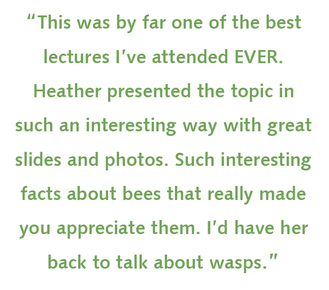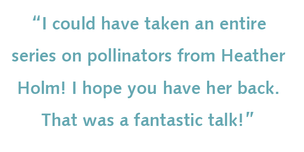|
To schedule an author event, please email [email protected]
|
|
PRESENTATION TOPICS
Oaks, Fire, and Climate Change NEW Natural landscapes in the US and Canada have been drastically altered by human activities such as infrastructure development, logging, overgrazing, introduction of invasive species, and fire suppression. However, prior to Euro-American settlement, highly functional and biodiverse oak and/or pine grassland systems dominated throughout much of the continent. With the current threat of climate change, it is crucial to understand the past and present ecological conditions of these landscapes to inform future restoration efforts. The presentation will look into the past to understand grassland systems at the time of Euro-American settlement and discuss how Native Americans managed and influenced the composition of these grassland systems with their regular use of fire. Heather will also discuss the impacts of fire as a strong selective pressure on keystone plants and bees. Pivoting to look into the future using projected climate modeling, Heather will address the ecological conditions today, focusing on oak ecosystems and grasslands, then paint a picture of what a functional, biodiverse, and resilient landscape may look like in the future, and what actions are needed to achieve these outcomes. Bumble Bee Banquet NEW Bumble bees (Bombus) are by far the most charismatic and recognizable native bees. To help bumble bees thrive, we must understand their life cycle, nesting behaviors, and nutritional needs. Heather will illustrate the bumble bee life cycle through the growing season, the importance of selecting the right native (woody and herbaceous) plants to meet the nutritional needs of the queens, workers, males, and gynes, bumble bee habitat enhancement, and factors impacting bumble bee populations. Specialist Bees NEW The monarch butterfly is probably the most famous insect specialist (the caterpillars feed only on milkweed), but did you know that many native bees are also specialists? Female native bee specialists or oligoleges, collect pollen from a narrow range of native plants; this could mean just one plant genus or species, or many genera that belong to one plant family. Heather will highlight many of these native plant-bee specializations as well as the overlapping habitat requirements of the bees and plants. The presentation will also include the threats to specialists such as habitat loss and climate change. Native Predatory Wasps: Their Role as Pollinators and Beneficial Insects NEW Native bees and predatory wasps share the same lineage and also share many behaviors and habitat requirements. Predatory wasps feed their offspring insects (and spiders) and bees diverged from this carnivorous diet to feed their offspring plant-based food (pollen and nectar). Flower-rich landscapes provide critical habitat for both adult bees and wasps because they each consume flower nectar; in addition, wasps need diverse, flower-rich landscapes to hunt for their prey. Heather will highlight many amazing natural history and biology facts about native wasps illustrating their nesting habitat, prey specificity, and the ecosystems services they provide—pest insect population control and pollination. Asters and Goldenrods: Autumn’s Pollinator Banquet Asters are critical late summer and fall forage for native bees including many pollen-collecting specialists. Heather will explore the nutritional components of the nectar and pollen of asters and their fall-blooming cousins the goldenrods, and demonstrate the importance of these two groups of plants for native bees as well as migratory pollinating insects such as butterflies. What's the Buzz About Native Bees This presentation explores the nesting habitat, life cycle, pollen collection, brood rearing, and general characteristics of common genera of native bees occurring in the Midwestern, Eastern United States, and southern Canada. The pollination of native plants and the mutualism between native plants and native bees is also highlighted. Heather also discusses the presentation of floral resources and how the physical characteristics of bees can influence the bees' effectiveness as pollinators. The Pollination of Native Plants This presentation is a fascinating journey showcasing the development of different flower types and the presentation of floral resources to pollinators. Exploring the types of insect pollinators, their foraging behavior, and the floral features that attract pollinators, Heather will provide many specific examples of how native plants are pollinated and what pollinator is most effective and why. Attracting Bees and Beneficial Insects with Native Plants Most insects have a positive impact in our landscapes. Native plants can be selected to attract specific bees and beneficial insects including predatory and parasitic wasps, beetles, flies, true bugs, and lacewings. Learn about the predator-prey relationships of these flower-visiting beneficial insects and how they help keep problem insect populations in balance. The life cycles, diversity, and nesting habitat of native bees will also be covered along with examples of native plants for different site conditions. The Corner Lot - Chronicles of a Small Scale Neighborhood Restoration (Minnesota and Wisconsin audiences) In urban environments, natural landscapes that were once biodiverse and contiguous have been transformed to small and often highly degraded fragments. What potential do these sites hold for ecological restoration, pollinator habitat, and public demonstration sites? How does one go about restoring a site such as this? Step one is developing a plan that includes goals, objectives, and methods. Heather will address these steps and highlight some of the challenges, opportunities, and amazing outcomes that have unfolded in her neighborhood corner lot restoration. She will also discuss pollinator habitat enhancement and management considerations, and celebrate the diverse pollinator populations that now thrive in the corner lot. Attracting Bees and Beneficial Insects to your Fruit and Vegetable Garden Learn about the importance of insect pollination and the bees responsible for pollinating the fruits and vegetables we grow in both home and commercial landscapes. Heather will discuss in detail the genera of bees responsible for the majority of the pollination and the additional forage (flowering plants) one needs to provide to ensure that the 'flower buffet' is always open, even when the fruit or vegetable plants are not in flower. Also discussed are the beneficial insects that the native flowering plants will attract and how these insects can help reduce insect pest populations in your fruit or vegetable garden. Habitat Matters: Lessons Learned From Enhancing Native Bee Habitat on Blueberry Farms In this presentation you will learn about the current research project I am working on in Minnesota and Wisconsin blueberry farms. I discuss the project objectives and reasons for studying native bees on blueberry farms, the sampling methods, native bee candidates (for blueberry pollination services), the nesting habitat of the bees, and the native plant forage recommendations. The presentation also explores the habitat evaluation of the farms, and the considerations for what kind of forage could be provided for the native bee candidates pre, and post-blueberry bloom. |
2024 SCHEDULED EVENTS
January 27, 2024 Celebrating the Avon Hills St. John's University, MN February 8, 2024 Wild Ones SE MN Prairie Partners February 15-16, 2024 Plan it Native Conference, Kansas City, MO February 27-29, 2024 Best Practices for Pollinators Summit March 9, 2024 Erie County Master Gardeners, Cornell Extension, NY March 12, 2024 Minnesota Shade Tree Short Course March 15, 2024 Shenandoah Valley Plant Symposium, VA March 26, 2024 Lexington Living Landscapes, MA April 9, 2024 Cheshire Pollinator Pathway April 11, 2024 Cottagewood Garden Club April 13, 2024 Anoka County Master Gardeners April 14, 2024 The Thinking Spot Bookstore June 1, 2024 Cape May Point Science Center June 9, 2024 Virginia Master Gardeners June 18, 2024 Kettle Moraine Land Trust June 20, 2024 Jenkins Arboretum and Gardens (virtual presentation) June 27, 2024 Nisswa Garden Club July 2, 2024 Chautauqua Bird, Tree, & Garden Club Chautauqua, NY July 17-19, 2024 Cullowhee Native Plant Conference July 24, 2024 Blue Ridge Prism, Virginia July 31, 2024 City of Burnsville August 18, 2024 Water Garden Society, MN August 19, 2024 Rochester Community College, MN September 14, 2024 Massachusetts Master Gardener Symposium September 21, 2024 Bellevue Botanical Garden, WA October 12, 2024 Hamilton County Master Gardeners, Indiana November 20, 2024 Rochester Community College, MN View Listing of Past Presentations |
© 2024 Heather Holm. All rights reserved. | Contact [email protected] |


